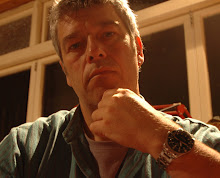

I got a bit sidetracked with that last post. I meant to be detailing my processes in coming up with the Constructions exhibition. So, back to task.
From where I parked my car the walk to Art School took me past the stadium construction site so I was aware of progress and changes as they occurred day to day.
Once, when I was struggling with too many different projects while studying at the Design Dept. of Otago University, Nick Laird suggested I try to find a common link between them all. I took that to mean to choose your projects so that you are working on different aspects of the same thing for different courses. Thats what got the stadium going for me as my coursework exhibition subject.
From then on I stepped up photography when I could (shooting with the camera mast is very weather dependent, more than a breeze and you pack up). At a certain point I felt some relief from the pressure to gather images because I had most of the raw material for a show. However, the construction site is a changing thing and large machines would appear at different locations on site from day to day and new structures would appear making it difficult to try to portray an up to date view of how the site looked.
In 2004/5 while in Switzerland I was contracted for a while to photograph buildings. For this I used an elevated camera on portable camera mast. It is a series of telescopic tubes with a fold out base. The camera is set at the top and then the sections are raised and locked off one by one until the camera is at the desired height. The maximum reach is 16m or about four stories. I have been using this equipment in New Zealand to photograph buildings for real estate. With this exhibition have begun to realise the creative potential of the camera mast.
I decided to use the proportional distortion technique on the construction site images for roughly the same reasons that I used it on landscape images. That is; it transformed the scene into something at once familiar and unusual, it compressed the same amount of information as a wide panorama into a proportional format (about 4:3) that is easier for the eye to scan, there is somehow a kind of thrill or exaggerated response to the image in line with the exaggerated proportions. It also can be scene as a kind of alienation device that changes the viewers relationship with what has been a very contentious subject. I was also aware that I was using the distortion in much the same way as I used tilt-shift for the accompanying images; I believe it to be a mature technique (or possibly a tool) to be used to show a subject in a new way.
Another reason is that it is mine. I developed it from scratch rather than, in the instance of tilt-shift, taking on an established technique for my own uses. As such it is in my interest to keep working with it, to develop it further and stake an artistic claim upon it as my own practice.
I used a slightly different formula than previously in coming up with the proportions. I composed and cropped the undistorted image as I liked and then sized it according to the paper size of the Otago Polytechnic large format printer. So each image (bar one) was printed at 610mm x 900mm although they came from varying sized undistorted panoramas. So each image is distorted in an arbitrary way, not that it seems to be noticeable.


No comments:
Post a Comment